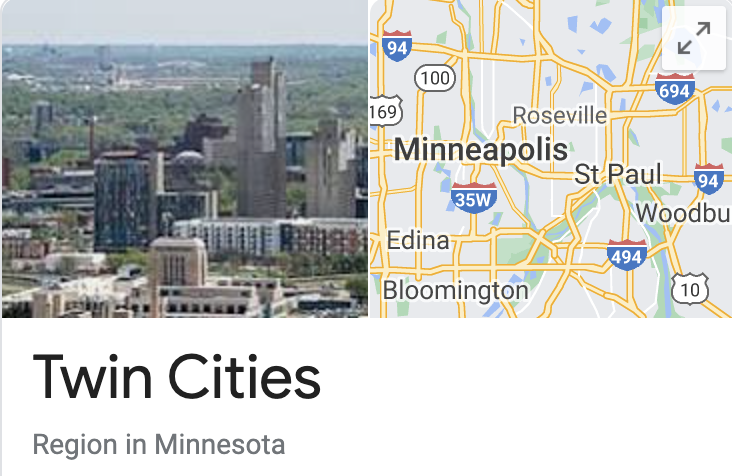Minneapolis MN
Minneapolis is a major city in Minnesota that forms “Twin Cities” with the neighboring state capital of St. Paul. Bisected by the Mississippi River, it’s known for its parks and lakes. Minneapolis is also home to many cultural landmarks like the Walker Art Center, a contemporary art museum, and the adjacent Minneapolis Sculpture Garden, famed for Claes Oldenburg’s “Spoonbridge and Cherry” sculpture.
Minneapolis is the most populous city in the US state of Minnesota and the seat of Hennepin County. With an estimated population of 429,606 as of 2019, it is the 46th most populous city in the US. Seven counties encompassing Minneapolis and its neighbor Saint Paul are known as the Twin Cities. In 2019, those counties are among sixteen making up the Minneapolis–St. Paul–Bloomington MN–WI metropolitan area of 3.6 million, and twenty-two making up the combined statistical area of 4.0 million.
Minneapolis lies on both banks of the Mississippi River, just north of the river’s confluence with the Minnesota River, and adjoins Saint Paul, the state’s capital. With one of the nation’s best park systems, the city is abundantly rich in water, with thirteen lakes, wetlands, the Mississippi River, creeks and waterfalls, many connected by parkways in the Grand Rounds National Scenic Byway. The city and surrounding region is the largest population and primary business center between Chicago and Seattle. Minneapolis was historically a marketplace for timber, became the flour milling capital of the world, and, to the present day, preserved its financial clout.

Places to visit while in Minneapolis
The Mall of America is a shopping mall located in Bloomington, Minnesota, a suburb of the Twin Cities in Minnesota, United States. It lies southeast of the junction of Interstate 494 and Minnesota State Highway 77, north of the Minnesota River, and across the Interstate from the Minneapolis St. Paul International Airport. It opened in 1992, and is one of the largest shopping malls in the world. The mall is managed by the Triple Five Group. Eighty percent of visitors to the Mall of America are from Minnesota, Wisconsin, Iowa, Nebraska, the Dakotas, Illinois, Ohio and Canada.
Minnehaha Park is a city park in Minneapolis, Minnesota, United States, and home to Minnehaha Falls and the lower reaches of Minnehaha Creek. Officially named Minnehaha Regional Park, it is part of the Minneapolis Park and Recreation Board system and lies within the Mississippi National River and Recreation Area, a unit of the National Park Service. The park was designed by landscape architect Horace W.S. Cleveland in 1883 as part of the Grand Rounds Scenic Byway system, and was part of the popular steamboat Upper Mississippi River “Fashionable Tour” in the 1800s.
The Minneapolis Institute of Art is an arts museum located in Minneapolis, Minnesota, United States. It is home to more than 90,000 works of art representing 5,000 years of world history. Its permanent collection includes world-famous works that embody the highest levels of artistic achievement, spanning about 20,000 years and representing the world’s diverse cultures across six continents. The museum has seven curatorial areas: Arts of Africa & the Americas; Contemporary Art; Decorative Arts, Textiles & Sculpture; Asian Art; Paintings; Photography and New Media; and Prints and Drawings.
The Walker Art Center is a multidisciplinary contemporary art center in the Lowry Hill neighborhood of Minneapolis, Minnesota, United States. The Walker is one of the most-visited modern and contemporary art museums in the United States and, together with the adjacent Minneapolis Sculpture Garden and the Cowles Conservatory, it has an annual attendance of around 700,000 visitors. The museum’s permanent collection includes over 13,000 modern and contemporary art pieces including books, costumes, drawings, media works, paintings, photography, prints, and sculpture.
Mill City Museum is a Minnesota Historical Society museum in Minneapolis. It opened in 2003 built in the ruins of the Washburn “A” Mill next to Mill Ruins Park on the banks of the Mississippi River. The museum focuses on the founding and growth of Minneapolis, especially flour milling and the other industries that used hydropower from Saint Anthony Falls. The mill complex, dating from the 1870s, is listed on the National Register of Historic Places. It is part of the St. Anthony Falls Historic District and within the National Park Service’s Mississippi National River and Recreation Area.
The Minneapolis Sculpture Garden is an 11-acre park in Minneapolis, Minnesota, in the United States. It is located near the Walker Art Center, which operates it in coordination with the Minneapolis Park and Recreation Board. It reopened June 10, 2017 after a reconstruction that resulted with the Walker and Sculpture Garden being unified as one 19-acre campus. It is one of the largest urban sculpture gardens in the country, with 40 permanent art installations and several other temporary pieces that are moved in and out periodically.
The Stone Arch Bridge is a former railroad bridge crossing the Mississippi River at Saint Anthony Falls in downtown Minneapolis, Minnesota. It is the only arched bridge made of stone on the entire Mississippi River. It is the second oldest bridge on the river next to Eads Bridge. The bridge was built to connect the railway system to the new Union Depot, which at that time was planned to be built between Hennepin Avenue and Nicollet Avenue.

